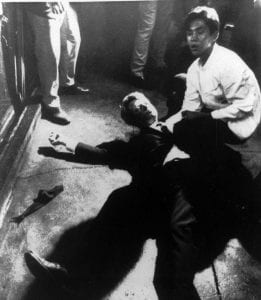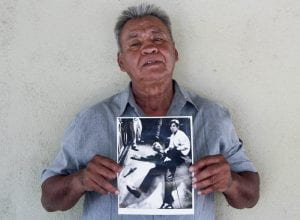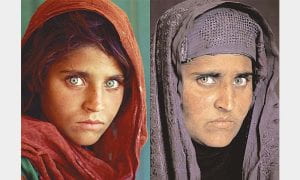TASK:
Examine each of the photographs below. What components of the image stand out? Is there a sign of weakness or strength?
Does the image appear posed?
Think about why the image was taken from the angle the photographer chose. Does it bring the viewer closer the subject?
Are there details in the image that tell more of the story?
Which elements bring up new questions?
Background
Photographs can tell use about times and places where we have not been or remind us of details we may not have noticed in a given moment. A photographer, like any artist, can bring his or her own point of view into their work by choosing the setting, repositioning their subject, and even choosing the lighting conditions in which they shoot the picture. All of these choices influence how we see what the photographer wants us to see.
Sometimes, the subject is unaware of the impact that the photo being taken can have on others. Often, this is because the experience they are having while being photographed requires all of their attention, such as feeding hungry children, or even walking to school safely. The implications of what the image could become, 10, 50, or 100 years from now are hard to fathom.
In 1936 Dorothea Lange photographed a mother of seven who was a migrant worker. She was following the pea harvest but the ground was frozen, leaving nothing to pick. The mother was housing her family in a lean-to, having just sold the family tent and the tires off the family car. While she was 32 when the image was taken, she appears to be a much older woman. These images were used to document the work of the Resettlement Administration, later called the Farm Security Administration.
This image, called “Migrant Mother”, was immediately published in a San Francisco paper and the federal government sent 20,000 pounds of food to the camp where she was photographed. It is said that it inspired John Steinbeck to write “Grapes of Wrath”. Lange later said she was drawn to the site after completing her work, and mailing her film back to Washington, DC. She only shot five images, and did not approach anyone but Florence Owens Thompson at the camp.
Teacher note: Students may better understand the context of Dorothea Lange’s work by seeing other images she has taken throughout her career. Here is a Dorothea Lange slideshow from the Museum of Modern Art.
EXAMPLE B
In 1957, fifteen-year-old Dorothy Geraldine Counts and three other students became the first African American students to attend the previously all white Harding High School in Charlotte, North Carolina. They were greeted by angry white mobs that screamed obscenities and racial slurs at the African American students. Counts’s picture appeared in many newspapers, as did others of black students attempting to attend white schools for the first time. Counts’s family feared for her safety and withdrew her from Harding and sent her to a completely integrated high school in Pennsylvania, after four days of her enduring the taunting. The image, by Douglas Martin for the Associated Press, was the photo of the year in 1957.
Later that year, language was added to the decision Brown Vs. Board Of Education that read that communities were to desegregate their schools “with all deliberate speed.”
EXAMPLE C
Robert Kennedy is Assassinated (1968)
On June 5, 1968, Robert Kennedy learned that he had been nominated as the democratic candidate for President, just months after the death of his brother, John Fitzgerald Kennedy had been captured on film. It was an assassin’s bullet that hit Robert Kennedy just after midnight in the Ambassador Hotel, as he exited the ballroom through the kitchen.
While there are theories about whether or not there was one assassin or two, it cannot be disputed that Kennedy was photographed in the arms of a 17-year old bus boy named Juan Romero, a Mexican immigrant who later confessed that he traded tasks with his co-workers to meet his role model that evening. He’d been the subject of much discrimination at work, and was inspired by Kennedy’s plans for The United States.
The politician was bleeding from the head as Romero supported him and offered prayers of comfort to his idol, who died 26 hours later. Bill Eppridge, a photojournalist who was assigned to cover the campaign captured the image. In 2004, Eppridge said, “It went through my mind not to take the picture, but this was history.”
Hubert Humphrey replaced Robert Kennedy as the democratic nominee for President, who was unable to defeat Richard Nixon. After Robert Kennedy’s assassination the United States Secret Service provided protection to presidential candidates.
FYI: Here is what Juan Romero looks like today:
EXAMPLE D
In 2002, the face of another woman caught the attention of the world. Sharbat Gula, thought to be 29, was found in the mountains of Pakistan, some 17 years after an image of her piercing green eyes turned the attention of world to the plight of refugees. Known since June 1985 as simply, “The Afghan Girl,” orphaned at six due to a Soviet bombing, her grandmother lead her on foot to various camps in Pakistan. She had never been photographed since that visit, and was surprised that millions had seen her photo.
By examining patterns in her irises, the part of the eye that are a brilliant green, an ophthalmologist in Pakistan and a forensic examiner for the Federal Bureau of Investigation in Washington, D.C., confirmed that the girl in the image was Sharbat Gula. Her request to help girls, like her own, to receive a proper education resulted in the founding of a $1,000,000 project now called the Afghan Children’s Fund.






